
|

|
|
Home Site Search Contact Us Subscribe
|
|
From the Treetops #3: Is Art Redefining the Architecture of Sacramento? Temporary, multi-disciplinary arts projects are transforming the proverbial "white cube" gallery town by elevating the discourse around what art can be and the potential spaces it could occupy. By Jason A. Silva, AIA, LEED AP March 8, 2018 Editor’s note: This is the third in a new ANN series penned by Jason A. Silva, AIA, LEED AP, principal of Dreyfuss + Blackford Architecture. The series title comes from a reference to Sacramento, California, famed as one of the most tree-populated cities in the world.
Along with literature, music, and architecture, art can represent a culture and contribute to regionalism – a mirror of its people. However, a city's identity can degrade to the benign and indistinct unless something causes an impact for change. For Sacramento, that something started in early 2016.
I've always had great fascination with the work of artist Gordon Matta-Clark and his self-described Anarchitecture – a combination of anarchy and architecture. He created temporary works out of abandoned buildings by sawing and cutting large sections through walls and floors – opening conical and geometric forms out to the street – giving new life and exploration into voids and perspectives not seen before. Matta-Clark's work challenged perceptions of what art is, and influenced architecture in profound ways.
ArtHotel was born in early 2016, from an abandoned five-story Jade Apartments in downtown Sacramento. It was the embodiment of that very need to challenge the traditional art establishment. Until then, this city had been the proverbial “white cube” gallery town – until a group of artists and arts leaders elevated the discourse around what art can be and the potential spaces it could occupy. They formed a local arts initiative under the moniker of M5arts to create this change. One hundred and forty artists contributed to every space and surface in the former Jade building. Open for only nine days and free to the public, some 15,000 people visited the site. The building was slated to be torn down after the installation closed. As an extension of the temporary, we led a team that laser-scanned the entire structure and then hosted it in an online gallery for another 30 days, called the Virtual ArtHotel. Laser scanning allowed online visitors to fly through a 3D point cloud and view 360° photos from 122 different scan locations within the building – as though they were there experiencing it in person.
The following year, M5arts opened ArtStreet – a temporary, multi-disciplinary arts project in a 65,000-square-foot indoor-outdoor gallery space occupying a warehouse rented for $3.75. More than 45,000 visitors came to see art and performances over a three-week period. Local artists were joined by international artists, creating a buzz unparalleled to date. Ginger Thompson, my artist partner and colleague at my firm, and I spent a month working nights and weekends with numerous volunteers to suspend a massive 1,200-square-foot art piece from the ceiling of the 32-foot-tall warehouse. The city felt something extraordinary was happening.
This year, the M5arts team is working on something even bigger. Currently dubbed “The Project” (with a certain level of secrecy as it is being developed), it will be permanently held in a 200,000-square-foot multi-story space described by M5arts organizers as an "amalgamation of artist, exhibition and sonic spaces, immersive theater, performance, cinema, dance and culinary education." Located central to downtown Sacramento and envisioned as an exploration into art, it will be a constantly changing and growing educational forum. Just as ArtHotel and ArtStreet were groundbreaking, this space will challenge the future of art and creativity in Northern California. Stay tuned.
Jason A. Silva, AIA, LEED AP, is a partner and design principal with Sacramento-based Dreyfuss + Blackford Architecture. His work is predominantly performance driven, advanced by technologies in design and fabrication. Both a builder and an artist with public art commissions, Silva brings design and architecture into the public realm.
Also by Silva:
There is a laundry-list of possibilities for creating those oh-so important physical and the more elusive perceived connections to our urban waterfront. Critical to the success of riverfront development: access, activation, and awareness.
From the Treetops #1:
Sacramento: Unheralded City of the Future?
|
(click on pictures to enlarge) 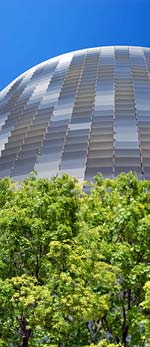 © Dreyfuss + Blackford Architecture From the treetops 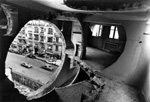 Conical Intersect, 1975. © Gordon Matta-Clark and David Zwirner, New York Gordon Matta-Clark’s seminal work "Conical Intersect" creates voids in a building slated for demolition at the Paris Biennale of 1975. 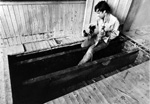 "Camera Lucida: Reflections on Photography" by Roland Barthes (Hill and Wang, New York, 1981) Gordon Matta-Clark, "Doors, Floor, Doors," 1976 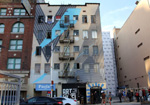 Dreyfuss + Blackford Architecture During the short exhibition, thousands lined up each day to tour ArtHotel. 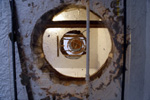 Jason A. Silva "Jade Totem" by Nick Deamer cuts through and suspends sections of the ArtHotel floor.  Dreyfuss + Blackford Architecture/Jason A. Silva A wooden man by artist-team Shaun Burner and Franceska Gamez intersects the spaces with its torso in one room and lower-half in another.  Dreyfuss + Blackford Architecture/Jason A. Silva ArtHotel laser scan section through point cloud 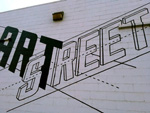 Will Smith ArtStreet 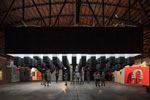 Art Gray "Section," a suspended installation by Jason A. Silva and Ginger S. Thompson. |
© 2018 ArchNewsNow.com